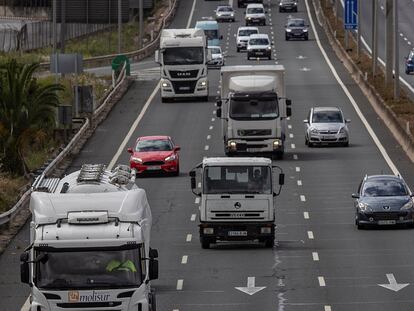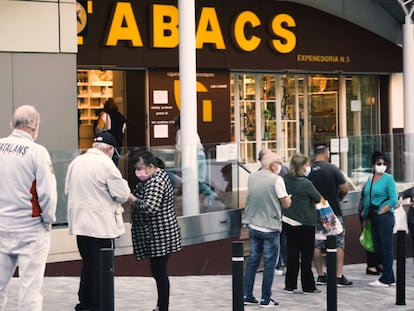April 2020: The month that tourism to Spain vanished
There were no international visitors and there was zero spending, according to recent figures that confirm the blow from the coronavirus lockdown to a major sector of the economy

April 2020 was defined by the complete collapse of tourism in Spain due to the coronavirus crisis. And the fact that it was expected did not make it any less traumatic. The sector is now facing the crucial summer season – the time of the year that generates the most revenue – with a high dose of uncertainty.
Figures released in recent days have only confirmed the complete lack of activity in the tourism industry. Not a single hotel was open in April, and not one international visitor showed up, leading to zero tourist spending, according to the National Statistics Institute (INE).
The tourism sector is now waiting eagerly for July 1, when international travel is expected to be allowed again
“During the month of April, the number of international visitors going to Spain for reasons of tourism through any entry point was zero,” said the INE in a release, explaining that the few trips that were undertaken that month were in all probability made for work and other reasons not associated with leisure.
This 100% contraction represents a serious blow to the economy, since tourism contributes over 12% of Spain’s gross domestic product (GDP). In April 2019, by comparison, Spain welcomed in excess of seven million visitors, who spent more than €7 billion.
The numbers were already starting to look bad in March, when there was a 64% drop in visitor figures from the same month in 2019, down to two million. Tourist spending shrank by 63.3% to €2.2 billion.
And May figures are expected to be almost as bad, although a few regions have been scaling down confinement faster than others, particularly a few islands in the Balearics and the Canaries that are already in Phase 3 of the deescalation plan. Yet the looser conditions may come too late for many small businesses without enough liquidity to survive for two months with no activity.
The INE’s figures confirm the observed effects of the border closure – one of several measures introduced by Spanish authorities to curb the spread of the coronavirus in one of the world’s hardest-hit countries. The government declared a state of alarm in mid-March and introduced domestic restrictions on citizen mobility, compounding the industry’s woes.
The tourism sector is now waiting eagerly for July 1, when international travel is expected to be allowed again, coinciding with the end of Spain’s ongoing deescalation process and of the mandatory quarantine for people coming into the country. The Canary and Balearic islands are even hoping to get an early start on the season in mid-June, although no specific date has been set yet.
Tourism has been driving the Spanish economy since the end of the Great Recession. But the sector is currently experiencing its toughest moment: tourist spending fell around 48% between January and April, from €22.4 billion to €11.7 billion. International arrivals dropped by half compared with the same period in 2019, from 21.3 million to 10.5 million.
English version by Susana Urra.
Tu suscripción se está usando en otro dispositivo
¿Quieres añadir otro usuario a tu suscripción?
Si continúas leyendo en este dispositivo, no se podrá leer en el otro.
FlechaTu suscripción se está usando en otro dispositivo y solo puedes acceder a EL PAÍS desde un dispositivo a la vez.
Si quieres compartir tu cuenta, cambia tu suscripción a la modalidad Premium, así podrás añadir otro usuario. Cada uno accederá con su propia cuenta de email, lo que os permitirá personalizar vuestra experiencia en EL PAÍS.
¿Tienes una suscripción de empresa? Accede aquí para contratar más cuentas.
En el caso de no saber quién está usando tu cuenta, te recomendamos cambiar tu contraseña aquí.
Si decides continuar compartiendo tu cuenta, este mensaje se mostrará en tu dispositivo y en el de la otra persona que está usando tu cuenta de forma indefinida, afectando a tu experiencia de lectura. Puedes consultar aquí los términos y condiciones de la suscripción digital.
More information
Últimas noticias
Trump claims peace in Ukraine is near, but Moscow suggests otherwise
A survivor’s account of the Interoceanic Train accident: ‘We were scared because of the speed on the curve’
The Interoceanic Train, the Mexican alternative to the Panama Canal
What is known about the Interoceanic Train derailment in Oaxaca
Most viewed
- Oona Chaplin: ‘I told James Cameron that I was living in a treehouse and starting a permaculture project with a friend’
- Reinhard Genzel, Nobel laureate in physics: ‘One-minute videos will never give you the truth’
- Why the price of coffee has skyrocketed: from Brazilian plantations to specialty coffee houses
- Pablo Escobar’s hippos: A serious environmental problem, 40 years on
- Chevy Chase, the beloved comedian who was a monster off camera: ‘Not everyone hated him, just the people who’ve worked with him’











































